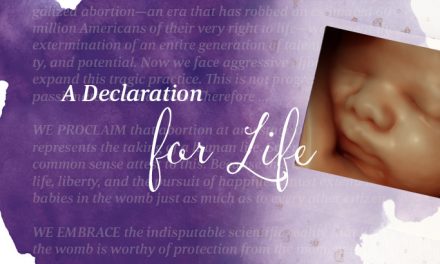The state of Indiana has appealed to the Supreme Court of the United States to hear a landmark pro-life case involving a state law designed to recognize the dignity of aborted babies and to prohibit the use of abortion to create “designer babies.” Signed into law by now then-Governor Mike Pence, the law would require that aborted babies be either cremated or buried, and the second part of the law would make it illegal to perform an abortion for discriminatory reasons based on race, sex or disability.
Indiana Attorney General Curtis Hill said, “The right to abortion declared by our Supreme Court protects only the decision not to bear a child at all, not a right to decide which child to bear. Our nation knows only too well the bitter fruits of such discrimination.” Hill’s statement gets to the heart of the issue.
Technology has given parents the opportunity to learn numerous things about their preborn child, but some families choose to use that information to decide whether a particular child should live or die by abortion. Children diagnosed in the womb with Down syndrome, spinal bifida and even cleft lip, a treatable condition, have all become targets of abortion. Medical professionals often encourage abortion due to their own ignorance of the condition or their belief that the child’s quality of life will be diminished, which plays into the uncertainty parents have about their child’s future.
This discrimination has been seen before. In the early 20th century, proponents of the eugenic movement in the United States believed that they could “breed” better citizens by limiting the reproduction of populations considered “feeble-minded” or those with mental disabilities. These diagnoses were often deeply flawed and valued human life based on genetics, race, class, family history, and possible contribution to society over their inherent worth as individuals created in the image of God. This movement had devastating consequences.
It resulted in mass institutionalization, forced sterilization, and mistreatment and neglect of those people considered “inferior.” The tenets of eugenics also contributed to Margaret Sanger’s birth control movement, which was the foundation of Planned Parenthood. Perhaps the most devastating consequence of the eugenics movement in the U.S. is the influence it had in other countries, especially Nazi Germany.
The Nazi regime’s first targets for mass murder were people institutionalized with intellectual and physical disabilities. In addition, Nazi officials also encouraged nurses and doctors to report newborn babies that were considered inferior to Reich Ministry as part of the euthanasia program. It is estimated that between 200,000 and 250,000 were killed. At the Nuremburg trials after the end of World War II, Nazi doctors cited the U.S. Supreme Court decision Buck v. Bell, which legalized forced sterilization for people considered inferior, as a justification for their own atrocities. After that, eugenics became a dirty word but its influence is still felt.
History is now repeating itself through abortion. Those preborn babies with disabilities or undesired characteristics are considered by some as appropriate targets for abortion. That is why Indiana’s Dignity for the Unborn Law is so important. A law like this will protect the most vulnerable because death is not a medical treatment.






